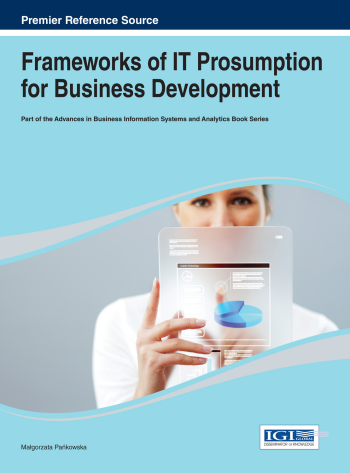
Publisher: IGI Global
390 pages
ISBN: 978-1-4666-4313-0 (hardcover)
Frameworks of IT Prosumption for Business
edited by Dr Malgorzata Pankowska, University of Economics in Katowice, Poland
Part of the Advances in Business Information Systems and Analytics Series
Premier Reference Source
This publication is aimed at providing a greater understanding of issues, challenges, trends of Information Technology prosumption effecting the overall utilization of digitalized goods and services in modern communities around the world.
Originally in economy the producers were consumers and the surplus of their production was sold by them on the market. However, because of work dividing, task sharing and specialization in Modern Age the producers have provided goods and services to the market, and they were forced to buy the basic goods. These processes are growing up and eventually the consumers are not able to create any goods at home (e.g., meals, clothing, shoes) and they must buy everything. However for some people there is still a dilemma: make or buy. Therefore, we can talk about prosumer as a special case of outsourcer.
The ability to efficiently produce large quantities of products has improved over time and with the studies. For many years, the production for own usage by producer was a marginal activity, covering mostly agriculture activities. As such the problem was mostly ignored as less valuable. In 1980 Alfred Toffler called them prosumers (contraction of producer + consumer) There was as Toffler said a small quantity of production for exchange i.e., for the market. But the production for sale was predominant. However now, there is another interpretation of prosumer when he or she is identified with active or innovative consumer.
In the academic literature, consumer demand is often assumed to be exogenous so that demand is usually taken to be a well-defined and pre-specified function of price and other product attributes such as quality. However now, companies are forced to use more sophisticated techniques. They must offer not mass products nor more product options and price points, not even customized products, but they should create opportunities for product development by end users. Some examples are given in other branches, e.g., IKEA provides furniture that must be composed by customers.
To address the recent developments, the book should present the research results of IT user-driven demand. This is an emerging research area that focuses on the evaluation of different innovative products, services and sales initiatives, and in all of these chapters it is critical to obtain a deeper understanding of IT user behavior first and then to develop efficient response to the behavior.
This book is published by IGI Global in August 2013
![Send mail [Send mail]](mailto.gif)

![Homepage [Home]](back.gif)